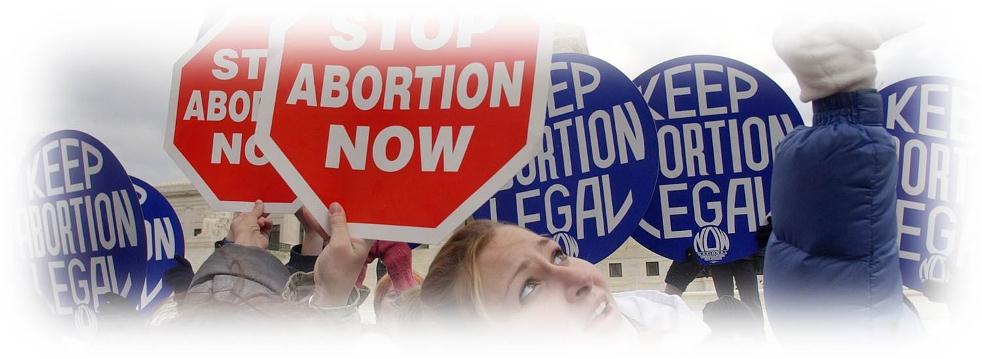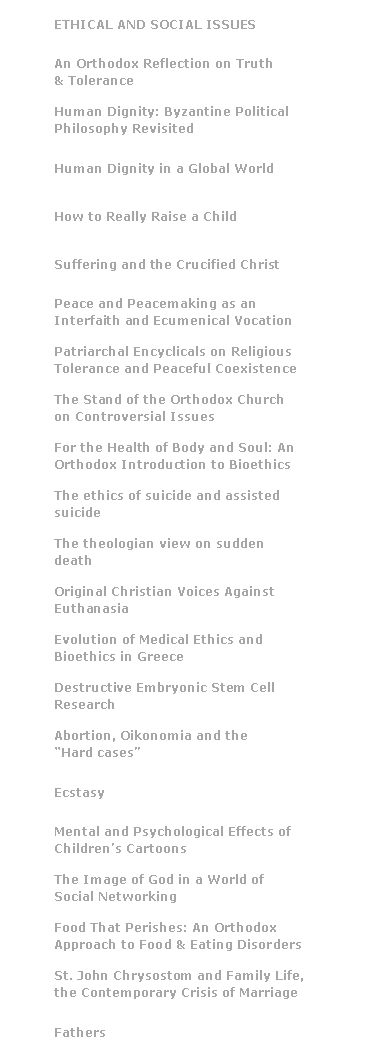Food That Perishes: An Orthodox Approach to Food and Eating Disorders
by Fr. George Morelli
Remove falsehood and lies far from me;
Give me neither poverty nor riches-�Feed me with the food allotted to me;
Lest I be full and deny You, And say, "Who is the LORD?" Or lest I be poor and steal, And profane the name of my God. (Proverbs 30:8, 9)
At first glance, considering food in the context of Orthodox spirituality and practice may seem inappropriate. But closer examination indicates, in fact, a rather intimate, meaningful connection between the two. We can see this in the quote from the Book of Proverbs that opens this essay. We should eat "the food allotted to us." To do otherwise is to make ourselves vulnerable to two spiritual dangers.
Problems with Food as a Spiritual Disorder
The first spiritual danger is that we may become so focused on food as an end in itself that it distracts us from what should be our true end: God. In the most basic and first of the commandments, God told us, "I am the LORD your God . . . You shall have no other gods before Me" (Exodus 20:2, 3). This commandment is echoed by Jesus: "'You shall love the LORD your God with all your heart, with all your soul, and with all your mind.' This is the first and great commandment." (Matthew 22:37, 38).
What is our treasure—God or food? As Our Lord told us, "For where your treasure is, there your heart will be also" (Luke 12:34). As our holy father Elder Paisios of the Holy Mountain tells us, "If you want to take someone away from God, give [them] plenty of material goods . . . [they] will instantly forget Him forever" (Ageloglou, 1998).
The second spiritual danger is sins against others and self. This may be a little harder to grasp. Our holy father St. Dorotheus of Gaza understood this danger so well. He asks: "If someone is offered a pleasant food [can he] not partake of it? [Can one] be careful and not overreach . . . and take more than [her] share? And what if the food is already divided into portions?" Is there an eagerness "to get a large portion . . . and leave a smaller portion?" (Wheeler, 1977).
The spiritual root of this danger is easily seen in the context of the second of the greatest commandments taught by our Lord: "You shall love your neighbor as yourself" (Mark 12:31). Our holy father St. Theoliptos said to monastics, "When you enter the refectory, do not look round to see how much food your brethren are eating and so fragment your soul with ugly suspicions. Look only at what lies before you. . . . Nourishing your body and spirit in this way, with your whole being you may truly praise Him who 'satisfies your desire with blessings' (Ps 103:5)." The danger here is not only a lack of charity, but also its offshoots of greed, envy, gluttony, and anger.
St. Gregory of Sinai has given us one of the most thorough discourses on how to partake of food. He astutely notes, "As the fathers have pointed out, bodies vary greatly in their need for food. One person needs little, another much to sustain his physical strength, each according to his capacity and habit." Speaking to those who are committed to a godly life, St. Gregory goes on to say such Christ-centered individuals "should always eat too little, never too much. For when the stomach is heavy the intellect is clouded and you cannot pray resolutely with purity."
Interestingly, the saint goes on to suggest an actual menu. The specific foods and quantities are geared to the monastic life and not particularly relevant to committed Christians living in the world. What is important and applicable, however, is that he does suggest a schedule and a specific list of foods. With regard to our commitment to Christ, St. Gregory points out, "Abstinence from specific types of food is most beneficial."
Problems with Food as a Medical/Psychological Disorder
For those who have a normal attitude toward food, the advice of Scripture and the fathers as given above may suffice to enable them to eat in a way that is pleasing to God. However, in our society, eating disorders are becoming increasingly common. Those with eating disorders need a more in-depth approach to the problem—one that combines spiritual, medical/psychological, and practical intervention to help them learn to eat properly.
There are two food-related problems classified as eating disorders according to the Diagnostic and Statistical Manual of Mental Disorders (American Psychiatric Association [APA], 2000):
Anorexia Nervosa is defined as the failure to maintain a minimally normal body weight (85% of expected weight). It is often accompanied by intense fear of gaining weight and the extreme misperception (overestimation) of actual weight.
Bulimia Nervosa is distinguished by recurring episodes of binge eating. There are two types: the purging type exhibits health-threatening compensatory behaviors such as self-induced purging (vomiting), overuse of diuretics, enemas, and laxatives; the non-purging type does not manifest these behaviors.
Both of these disorders are gender-related, with females showing a higher prevalence. There is evidence that both biological and social features may contribute to the occurrence of these disorders.
Obesity is defined as an excess proportion of total body fat wherein the person’s actual weight is 20% or more above normal weight for their sex and height. It may come as a surprise that obesity is not listed as an eating disorder. This is because eating disorders are consistently associated with dysfunctional psychological and behavioral syndromes, patterns, or characteristics (such as those noted above). Obesity is considered rather a "general medical condition" (APA, 2000). Clearly, however, psychological factors are often related to the cause and course of obesity.
Medical-Psychological Considerations in Eating Disorders
The medical consequences of eating disorders are critical. Accompanying anorexia nervosaare serious medical disturbances such as anemia, elevated blood urea, diminished liver function, attenuated thyroid function, lowered neuroendocrine function, heart and brain irregularity, and death. Associated psychological problems are depression, social withdrawal, insomnia, lowered sex interest, obsessive-compulsive features, social anxiety, poor impulse control, need for control, and alcohol and/or drug abuse.
Accompanying bulimia (purging type) can be potassium loss, leading to muscle weakness and heart irregularities; and fluid retention, leading to nausea, vomiting, headache, and malaise. Eventually, confusion, slower reflexes, convulsions, and/or coma may occur. Also associated with the purging type are significant and permanent loss of dental enamel, chipped and ragged teeth, increased dental cavities, enlarged glands, cardiac and skeletal myopathy, and esophageal and gastric ruptures. Females (90% of those diagnosed with this disorder) are subject to menstrual irregularity. Psychological problems concomitant with bulimiaof both types are mood disorders (depression) and substance abuse and dependence.
Some Psychological Interventions
The following techniques are not recommended for anorexic patients. Anorexia most often requires an in-patient setting, with hospital release the reward for weight gain (Craighead, Craighead, Kazdin & Mahoney, 1994). However, these techniques may prove helpful to patients dealing with bulimia or obesity.
Metacognition. This is thinking about our own thinking—knowledge and experiences we have about our own thinking processes. Another way of putting it is controlling our thinking about eating. A person with an eating problem could instruct herself, "Before eating anything I have to consult my eating plan." A sequence of control instructions might include: "Before eating, open my eating control pad, check the time of day, look at the food and amount I am to have. Just get out this portion on the list. Go to the kitchen table. Move away from all food after eating, return to previous or scheduled activity." As simple as this may sound, this metacognitive procedure of step-by-step "talking to oneself"was found to help patients with previous regulation and/or control problems (Meichenbaum, 1986).
Stimulus Control. Any healing of eating disorders or obesity requires a program of stimulus control. People respond to stimuli reflexively, without even thinking. For example: Pass refrigerator, open door. Contemporary research psychologists recommend changing the stimulus cues by using distinct signals such as location, size, color, and sensory modality (Martin and Pear 1992). For example, a sticky tape could be applied to a refrigerator or pantry door handle to modify the stimulus cue. A colorful "Think First" sign or large bold X could serve the same purpose. At home, one can restrict one’s eating to a single room, preferably seated at the kitchen table, rather than carrying a box of food from one room to another or sitting on a couch watching television. The problem eater could put the foods to be consumed in portion-sized packages in a special location, away from other family foods.
Response Management. The more difficult it is to respond to a stimulus, or the more complex the response, the easier it is to block it. A simple example: Reaching for a peanut is more difficult if the bowl is across the room or at the other end of the house than if it is within arm’s reach. Helpful response techniques include putting food on a saucer instead of a plate, using very small utensils, putting the utensil down after each bite, interrupting bites by sipping water, or getting up from the table. A chart can also be filled out as a requirement to eat: Before eating the person has to write day, time, place, food, and quantity on a chart. This could be initiated as a metacognitivestrategy as discussed above.
Reinforcement (reward) techniques. Bulimics and patients who overeat could also make a list of activities they like doing. These activities could serve both as a substitute for the inappropriate eating behavior and as a reward for complying with one’s healthy eating program. I have found a combination of daily and weekly rewards to work well. One overweight patient found it rewarding at the end of the day to take a bubble bath if she had complied with her eating program. Going to a play or music program with her husband on the weekend was her reward for following her program during the week before.
The Church’s Approach to Eating Disorders
Considering the severity of the medical and psychological consequences of eating disorders, the patient who suffers from one of them should not attempt self-treatment. Family or clergy who know an individual with these disorders should make a referral to an experienced, licensed health/mental health practitioner who specializes in such disorders. (Please note that a general practice physician or clinical psychologist is not necessarily an eating disorder specialist.) For Orthodox clergy and laity to make such a referral is in the firm tradition of our Church. St. Maximus the Confessor said that "grace builds upon nature" (Morelli, 2006). For the Orthodox Christian, this means that neither the spiritual nor the natural dimensions of human existence are ignored. A parish priest especially must be aware that many of the problems parishioners present to him have psychological components and that the spiritual healing of a person often involves psychological dynamics that require the aid of persons qualified to address and treat them. It is foolhardy and dangerous to assume all behavioral and cognitive problems have only a spiritual basis. As St. Basil said, medicine, too, must be taken into account in the healing of persons. We should take his words to heart. In the fourth century, various healing centers were opened and administrated by the Orthodox Church, including hospitals and homes for the poor, orphans, and aged (Demakis, 2004). Many of these centers were associated with monasteries. The health care workers—the physicians, nurses, and psychologists of the day—were often the monks themselves. St. Basil of Caesarea was trained in medicine and was reported to have worked with the monks in ministering to the ill and infirm. St. John Chrysostom as Patriarch of Constantinople used the wealth of the Church to open hospitals and other philanthropic institutions, which earned him great love from the people. Within two centuries, the rapid growth of these centers necessitated state funding, although the Church retained the active administration and care-giving in the arrangement. Emperor Justinian moved the most important physicians into the hospitals, which enhanced the reputation of these centers (Demakis 2004).
Treating the Whole Person
If one has a food-related problem, there are two possibilities. If one does not have a diagnosable eating disorder, then one could consider the problem to be a spiritual one and it should be dealt with spiritually.
If the problem with food is a diagnosable medical/psychological disorder, the person with this disorder would be considered to have an illness or infirmity, one that is most probably involuntary. This can only be determined, however, by a thorough medical examination followed by medical/psychological treatment. Even in eating problem cases that are medical/psychological, there is always a spiritual component. In the tradition of the early Church, the focus was on the healing of the whole person, body, mind, and spirit, accomplished by a synergy between medical science and the Holy Mysteries of the Church. St. John Chrysostom presented us with the idea that the entire Church of Christ is a hospital, thereby expressing in clearer theological terms the relationship between the healing of body and soul practiced by the early healers. In the Parable of the Good Samaritan (Luke 1:33ff), the Good Samaritan exemplifies Christ, who, as the Great Physician, comes to broken mankind (the man beaten by robbers) in order to bring healing. The inn to which the Good Samaritan delivered the suffering man is the Church (Vlachos, 1994, 1998).
The interrelationship between body and soul is noted in almost every liturgical prayer. Most corporate prayer begins with theTrisagion (Thrice-Holy) prayer, which makes the relationship clear: "All-holy Trinity, have mercy on us. Lord, cleanse us from our sins. Master, pardon our iniquities. Holy God, visit and heal our infirmities for Thy name's sake" (emphasis added).
This interrelationship is also demonstrated in the spiritual practices and Mysteries of the Church.
Disclosure of Thoughts. An initial step in dealing with eating disorders is the disclosure of the patient’s thoughts, behaviors, feelings, and symptoms. In a similar manner, the church fathers emphasized the importance of practicing this disclosure in a complete and systematic way. For the spiritual fathers, this is done with vigilance (nepsis), watchfulness, and the guarding of the heart. Haucherr (1990) quotes an anonymous old man as saying, "When evil thoughts harass you, do not hide them, but tell them at once to your spiritual father. The more one hides one's thoughts, the more they multiply and the stronger they become."
The Service of Holy Unction. Orthodox Christians perform the Mystery of Holy Unction for the healing of soul and body and for forgiveness of sins. In his epistle, the Holy Apostle James writes, "Is anyone among you suffering? Let him pray. Is anyone cheerful? Let him sing psalms. Is anyone among you sick? Let him call for the elders of the church, and let them pray over him, anointing him with oil in the name of the Lord. And the prayer of faith will save the sick, and the Lord will raise him up. And if he has committed sins, he will be forgiven" (James 5:13–15). The anointing prayer reads, "The blessing of Our Lord God and Savior Jesus Christ: for the healing of soul and body . . ."
The prayer of the blessing of the oil illustrates the goal of physical healing: that those anointed may glorify God and thus be spiritually healed. The prayer in part reads:
O Lord, who through Thy mercies and bounties heal the disorders of our souls and bodies: Do thou Thyself, O Master, also sanctify this oil, that it may be effectual for those who are anointed therewith, unto healing and unto relief from every passion, of every defilement of flesh and spirit, and every ill; that thereby may be glorified Thine all holy Name, of the Father, and of the Son, and of the Holy Spirit: now and ever, and unto ages of ages. Amen.
The Holy Eucharist. The Holy Eucharist is the reception of the Body and Blood of Our Lord, God and Savior, Jesus Christ. The Eucharist conjoins us to the Great Physician, a point expressed in the liturgical prayer that is read immediately before the elevation of the bread and wine: "We give thanks unto Thee, O King invisible, who by Thy measureless power hast made all things . . . look down from heaven upon those who have bowed their heads unto Thee . . . distribute these Gifts here spread forth unto all of us for good . . . heal the sick, Thou who art the physician of souls and bodies."
These spiritual disciplines can combine with a traditional medical approach to restore the whole person to a godly relationship with food.
The Food of Life versus the Food that Perishes
St. John of the Ladder counsels, "If you have promised Christ to travel the straight and the narrow road, then keep your stomach in check." And he also tells us, "Begrudge your stomach and your heart will be humbled: please your stomach and your heart will be proud."
And finally, let us heed the words of Our Lord Himself: "Do not labor for the food which perishes, but for the food which endures to everlasting life, which the Son of Man will give you, because God the Father has set His seal on Him" (John 6:27).
References
American Psychiatric Association. (2000). Diagnostic and Statistical Manual of Mental Disorders (DSM-IV-TR). Washington, DC. Ageloglou, Priestmonk Christodoulos. (1998). Elder Paisios of the Holy Mountain. Mt. Athos, Greece: Holy Mountain. Craighead, L.W., Craighead, W.E., Kazdin, A.E. & Mahoney, M.J. (1994). Cognitive and behavioral interventions: An empirical approach to mental health problems. Boston: Allyn & Bacon. Demakis J. (2004). "Historical Precedents for Synergia: Combining Medicine, Diakonia and Sacrament in Byzantine Times." In S. Muse (Ed.), Raising Lazarus: Integral healing in Orthodox Christianity. Brookline, MA: Holy Cross Orthodox Press. Hausherr, I. (1990). Spiritual Direction in the Early Christian East. Spencer, MA: Cistercian Publications. Martin, G. & Pear, J. (1992). Behavior Modification: What It Is and How To Do It. Englewood Cliffs, NJ: Prentice Hall. Meichenbaum, D. (1986). "Cognitive behavior modification." In F. H. Kanfer & A. P. Goldstein (Eds.), Helping people change: A Textbook of methods. 3rd ed. NY: Pergamon. Morelli, G. (2006, December 05). "Understanding Clergy Stress: A Psychospiritual Response."http://www.orthodoxytoday.org/articles6/MorelliClergyStress.php. St. John of the Ladder. (1982), John Climacus: The Ladder of Divine Ascent. NY: Paulist Press. Vlachos, Bishop Hierotheos, (1994). Orthodox Psychotherapy: The Science of the Fathers. Lavadia, Greece: Birth of the Theotokos Monastery. Vlachos, Bishop Hierotheos, (1998). The Mind of the Orthodox Church. Lavadia, Greece: Birth of the Theotokos Monastery. Wheeler, E.P. (1977). (ed., trans.), Dorotheos of Gaza: Discourses and Sayings. Kalamazoo, MI: Cistercian Publications.
Reprinted from the Fall 2008 issue of The Handmaiden Journal (Vol. 12, No. 4)









